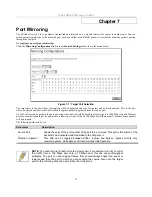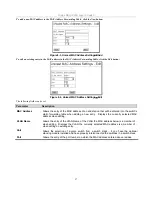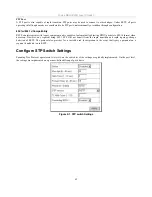
D-Link DES-3326S Layer 3 Switch
Chapter 9
Spanning Tree Protocol
802.1w Rapid Spanning Tree
Configure STP
The Switch supports 802.1d Spanning Tree Protocol (STP) and 802.1w Rapid Spanning Tree Protocol (RSTP). 802.1d STP
will be familiar to most networking professionals. However, since 802.1w RSTP has been recently introduced to D-Link
managed Ethernet Switches, a brief introduction to the technology is provided below followed by a description of how to set
up 802.1 d STP and 802.1w RSTP.
802.1w Rapid Spanning Tree
The Switch implements two versions of the Spanning Tree Protocol, the Rapid Spanning Tree Protocol (RSTP) as defined by
the IEE 802.1w specification and a version compatible with the IEEE 802.1d STP. RSTP can operate with legacy equipment
implementing IEEE 802.1d, however the advantages of using RSTP will be lost.
The IEEE 802.1w Rapid Spanning Tree Protocol (RSTP) evolved from the 802.1d STP standard. RSTP was developed in order
to overcome some limitations of STP that impede the function of some recent Switching innovations, in particular, certain
Layer 3 function that are increasingly handled by Ethernet Switches. The basic function and much of the terminology is the
same as STP. Most of the settings configured for STP are also used for RSTP. This section introduces some new Spanning
Tree concepts and illustrates the main differences between the two protocols.
Port Transition States
An essential difference between the two protocols is in the way ports transition to a forwarding state and the in the way this
transition relates to the role of the port (forwarding or not forwarding) in the topology. RSTP combines the transition states
disabled, blocking and listening used in 802.1d and creates a single state
Discarding
. In either case, ports do not forward
packets; in the STP port transition states disabled, blocking or listening or in the RSTP port state discarding there is no
functional difference, the port is not active in the network topology. The Comparing Port States table below compares how the
two protocols differ regarding the port state transition.
Both protocols calculate a stable topology in the same way. Every segment will have a single path to the root bridge. All
bridges listen for BPDU packets. However, BPDU packets are sent more frequently – with every Hello packet. BPDU packets
are sent even if a BPDU packet was not received. Therefore, each link between bridges are sensitive to the status of the link.
Ultimately this difference results faster detection of failed links, and thus faster topology adjustment. A drawback of 802.1d is
this absence of immediate feedback from adjacent bridges.
Table 1. Comparing Port States
802.1d STP
802.1w RSTP
Forwarding?
Learning?
Disabled Discarding
No
No
Blocking Discarding
No
No
Listening Discarding
No
No
Learning Learning
No
Yes
Forwarding Forwarding
Yes
Yes
RSTP is capable of more rapid transition to a forwarding state – it no longer relies on timer configurations – RSTP compliant
bridges are sensitive to feedback from other RSTP compliant bridge links. Ports do not need to wait for the topology to
stabilize before transitioning to a forwarding state. In order to allow this rapid transition, the protocol introduces two new
variables: the edge port and the point-to-point (P2P) port.
Edge Port
The edge port is a configurable designation used for a port that is directly connected to a segment where a loop cannot be
created. An example would be a port connected directly to a single workstation. Ports that are designated as edge ports,
transition to a forwarding state immediately without going through the listening and learning states. An edge port loses its
status if it receives a BPDU packet, immediately becoming a normal spanning tree port.
61






























